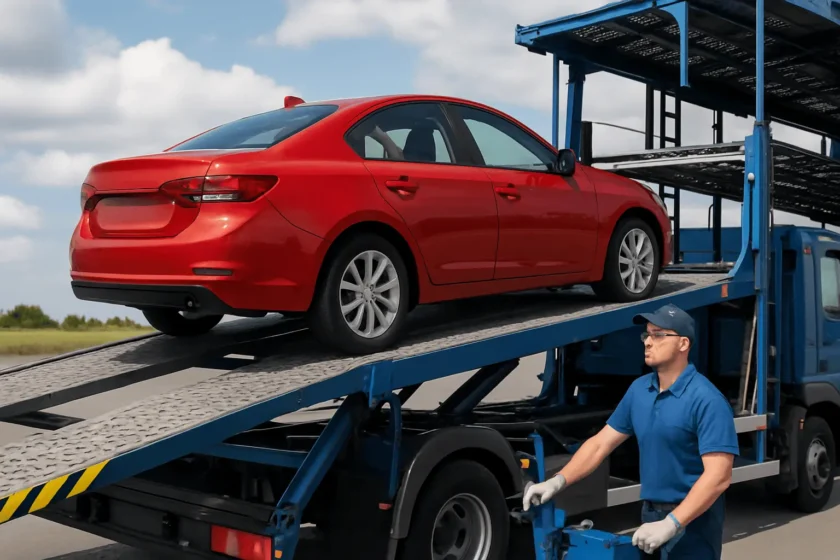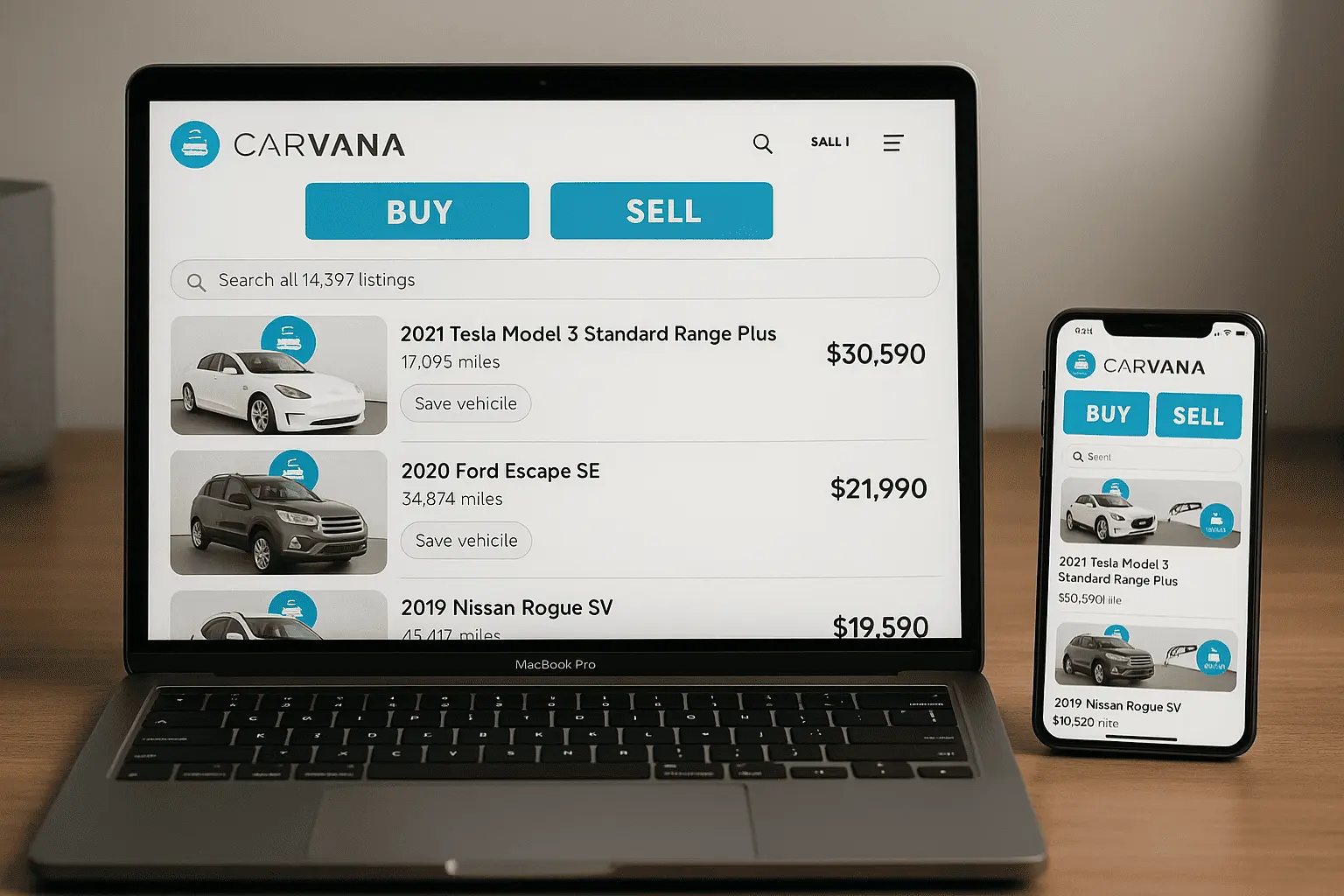Moving a vehicle across the country, or even just shipping it to another state, involves more steps than simply handing over your keys. The auto transport industry has grown so much over the decades that it has made it possible to move millions of vehicles each year, whether it’s a family car, a leased vehicle, or a rare collector’s car.
Key Takeaways
- Auto transport follows a clear 6-step process: getting a quote, booking and assigning a carrier, completing paperwork, pickup and inspection, transit and tracking, and final delivery verification.
- Average shipping cost ranges from $600 to $1,800 depending on distance, vehicle type, transport method, and timing.
- Distance and route matter most. Cross-country shipping costs less per mile but more overall, while rural or less-traveled routes increase prices.
- Vehicle size and condition impact price. Large or non-running cars cost $100–$200 more due to added weight, space, and loading labor.
- Open transport is most affordable, enclosed transport offers full protection ideal for classic, exotic, or luxury cars (30–60 % higher price).
The Process of Auto Transport
The exact steps of shipping a car may vary depending on various factors like your vehicle’s model, its condition, or the final delivery destination. Still, the process typically follows the same framework with several key aspects to consider.
1. Requesting a Quote
The first step is understanding what your shipment will cost. Auto transport rates are influenced by factors like:
- Distance: Cross-country routes are typically more expensive in total, yet cheaper per mile.
- Vehicle type and size: Larger or non-standard cars take up more space and add extra cost.
- Shipping method: Open carriers are more affordable, while enclosed auto transport provides additional protection at a higher price.
- Delivery timeframe: Expedited shipping also adds to the cost.
The easiest way to get a reliable and realistic estimate is by using an auto transport quote calculator. By providing information about your vehicle type, transportation method, and the final destination, you can receive an instant quote and plan your budget before booking.
2. Booking and Carrier Assignment
Next comes booking the service with the quoted price. This is when an auto transport broker or direct carrier assigns your shipment to a truck matching your shipment requirements. They will provide a written version of the auto transport contract detailing pickup and delivery dates, service type, and responsibilities of each party. Explain the different delivery options, so you can decide which one works best for you.
3. Completing the Paperwork
Proper document management is critical during any deal, and in auto transport, it’s no exception. The key documents for car shipping includes:
- Vehicle registration and insurance proof.
- Photo ID of the owner or an authorized representative.
- Written permission from lienholders or leasing companies if the vehicle isn’t fully owned. This is especially necessary when moving out of state with a leased car.
- Bill of Lading: At pickup, both you and the driver inspect the car’s condition and record every detail in a form. At delivery, the same checklist is reviewed to confirm if any damage occurred in transit.
4. Vehicle Pickup
The carrier will arrive to pick up your vehicle on the scheduled date. Depending on the services, this may suggest:
- Door-to-door shipping, when the truck arrives at your home or a nearby accessible spot.
- Terminal-to-terminal shipping, when you drop the vehicle at a central hub, and the carrier collects it from there.
At pickup there will be a final pre-loading inspection with the truck driver, signing the Bill of Lading, loading of the vehicle onto the trailer.
5. Transit and Tracking
Once your car is on the road, the carrier begins the journey to its destination. Depending on the distance, shipping may take 1-3 days for short or regional routes, and 5-10 days for coast-to-coast shipping.
During this time, most auto transport companies provide updates, either through customer service or direct driver contact. Some may even offer GPS-enabled tracking for added peace of mind.
6. Delivery and Final Inspection
Once arrived, your car will be unloaded and inspected again against all the points of the original Bill of Lading.
- Walk around the vehicle with the driver, checking for new scratches, dents, or damage.
- Compare the condition to the photos you took before pickup.
- If everything matches, sign off on the Bill of Lading. However, if there are discrepancies, you’ll need to note them on the form and file a claim.
Most carriers include insurance as part of their services. For greater clarity, review the coverage in auto shipping insurance to see your options.
How Much Does Auto Shipping Cost?
Auto transport pricing isn’t flat-rate; it shifts with distance, route, and vehicle details. On average, you can expect to pay $600 to $1,800 to ship a standard car within the United States. Factors like whether your car runs, the choice between open or enclosed transport, and the season of your move will all affect the final price.
Distance and Route
The most obvious factor in determining the cost is how far your car needs to travel.
For instance, a 2,000-mile cross-country shipment may average around 50-70 cents per mile, while a shorter 200-mile trip may cost over $2 per mile. The reason for this is that longer trips will cost more overall, but less per mile.
Route popularity also plays a role. Heavily traveled corridors like New York to Florida or California to Texas attract more carriers, thus lowering the prices due to competition. On the other hand, if you’re shipping to or from rural or less accessible areas, expect to pay more. In such cases, the carriers need to take detours or drive out of their way, as a result, increasing labor, time, and fuel costs.
Vehicle Size and Weight
Standard sedans and compact cars are the cheapest to ship because they take up less trailer space and add minimal weight. Larger vehicles like SUVs and pickup trucks are heavier and bulkier, which often means fewer vehicles can fit on the same trailer.
Carriers should also consider the weight restrictions imposed by the Department of Transportation. Exceeding the limits can lead to fines, so drivers must carefully balance how many vehicles they load. Expect a higher quote if your car is oversized or modified with a lifted truck or a van with aftermarket accessories.
Vehicle Condition
Whether your car is running or not also affects the price. A vehicle that starts and drives onto the trailer is much simpler to handle. Non-running vehicles require extra labor and equipment, such as winches, forklifts, or dollies, which add to the cost.
Even if your car is operable, certain mechanical issues may increase difficulty. Flat tires, leaking fluids, or faulty brakes can slow down loading and unloading, requiring additional tools and assistance. Providing accurate details about your car’s condition during the booking process avoids surprises and ensures the carrier arrives prepared.
If you are unsure about your car’s readiness, you can ask for an inspection checklist before pickup, helping you identify and resolve issues early.
Seasonality and Timing
Auto transport is a seasonal business, and timing your shipment can influence the price. Summer is the busiest season, with families relocating and students moving to or from college. Winter also sees spikes along certain routes, especially the “snowbird” corridor, as retirees move between northern and southern states.
Booking last-minute often means paying a premium, since carriers prioritize urgent loads at higher rates. Planning your shipment weeks in advance will give extra flexibility and better pricing. If possible, avoid peak demand months to keep costs manageable.
Types of Car Transport to Another State
When planning to ship a vehicle across state lines, one of the biggest decisions you’ll make is how the car will be transported. The method you choose affects the cost, delivery speed, and level of protection the vehicle receives.
Open and Enclosed Auto Transport
Open auto transport is the industry standard and the most widely used option. Cars are loaded onto a two-level open trailer, similar to the ones you often see delivering vehicles to dealerships. It’s affordable, widely available, but vehicles are exposed to weather and road debris.
Enclosed auto transport provides full coverage during transit. Cars are placed in fully enclosed trailers that protect them from rain, snow, dirt, and potential theft. Ideal for luxury, vintage, exotic, or collector cars. Costs 30-60% more than open shipping, and availability may be limited in certain regions.
Door-to-Door and Terminal-to-Terminal Car Shipping
Door-to-door service is the most convenient option for customers. The carrier picks up the vehicle as close to your home as possible and delivers it directly to the required address. Saves time and effort, but it costs more and pickup may happen at a nearby open space.
Terminal-to-terminal car transport suggests dropping your car off at a designated location and retrieving it from another terminal near your destination. It’s often cheaper than door-to-door services, flexible for customers who can work around pickup and drop-off schedules. Requires extra travel for the customers, as well as vehicles may sit at the terminal until the carrier is ready to move them.
How to Prepare Your Car for Shipping
Save our pre-shipping checklist to prepare your car for shipping and ensure it is fully ready for transport.
| Preparation Step | Why It Matters | Extra Notes |
| 1. Secure or remove loose accessories | Items like roof racks, bike carriers, or spoilers can be damaged in transit or cause safety issues. | If possible, detach aftermarket parts. Otherwise, fold or secure them tightly. |
| 2. Check tire pressure | Properly inflated tires reduce the risk of damage when loading/unloading. | Underinflated or overinflated tires may complicate inspections and handling. |
| 3. Reduce fuel level | Keeping the tank at about ¼ full minimizes weight and safety risks. | Carriers often recommend no more than a quarter tank. |
| 4. Deactivate toll tags and parking passes | Active toll transponders may charge fees while the car is in transit. | Remove or deactivate electronic passes before pickup. |
| 5. Verify insurance coverage | Most carriers provide liability coverage, but knowing your own policy terms is key. | Review details in your auto shipping insurance. |
| 6. Gather all necessary documents | Having paperwork ready avoids delays during pickup. | Ask for the required list in advance. |
| 7. Plan pickup and delivery access | Large trailers need space to maneuver. | If your street is narrow, coordinate a nearby meeting spot with the driver. |
| 8. Confirm special instructions | Non-running vehicles, modified cars, or leased vehicles may need extra preparation. | Discuss this in advance, preferably at the booking stage. |
Frequently Asked Questions
How Does Car Shipping Work?
At its core, car shipping is a logistics service. Licensed carriers move vehicles using specialized trailers, while brokers or transport companies coordinate the routes and schedules. Once you request a shipment, the company arranges for your car to be picked up, loaded, and transported to the destination. The system works because it combines customer demand with available carrier space, much like matching passengers with flights.
How Are Cars Shipped Across Country?
Vehicles traveling cross-country are usually shipped on multi-car carriers that run established interstate routes. Such long-haul drivers coordinate pickups and drop-offs along the way, often consolidating shipments to maximize efficiency. In some cases, high-value cars may travel in enclosed trailers or even by rail for part of the journey, but most coast-to-coast moves rely on highway carriers. Transit times range from several days to two weeks, depending on distance and scheduling.
What Is the Best Way to Ship Your Car?
The “best” method depends on your priorities. If you’re looking for affordability, open carriers are the most practical choice. For higher-value or classic cars, enclosed shipping provides better protection from different hazards. Customers who value convenience may prefer door-to-door service, while those aiming to save costs might choose the terminal-to-terminal option. The right one balances costs, protection, and scheduling based on your specific situation.
When Is the Cheapest Time to Ship a Vehicle?
The most affordable times to ship are typically during the off-peak seasons of late fall and early winter. Demand for carriers slows after the busy summer moving season and before the “snowbird” rush in early spring, which often lowers prices. Midweek pickups also tend to be cheaper than weekend requests, since drivers are filling gaps in their schedules.
Sources
- National Highway Traffic Safety Administration, “Traffic Safety Facts Annual Report Tables”, Accessed November 5, 2025.
- Federal Motor Carrier Safety Administration, “Registration – Getting Started”, Accessed November 5, 2025.






